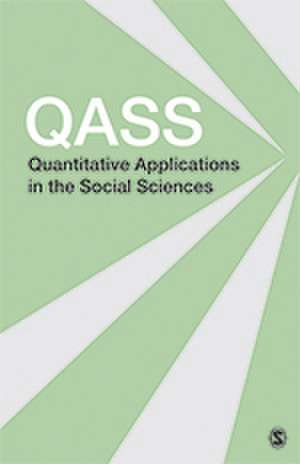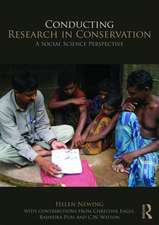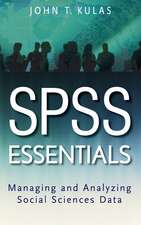Applied Correspondence Analysis: An Introduction: Quantitative Applications in the Social Sciences, cartea 121
Autor Sten Erik Clausenen Limba Engleză Paperback – 19 aug 1998
Din seria Quantitative Applications in the Social Sciences
-
 Preț: 306.08 lei
Preț: 306.08 lei -
 Preț: 270.02 lei
Preț: 270.02 lei -
 Preț: 270.25 lei
Preț: 270.25 lei -
 Preț: 272.08 lei
Preț: 272.08 lei -
 Preț: 270.29 lei
Preț: 270.29 lei -
 Preț: 304.51 lei
Preț: 304.51 lei -
 Preț: 313.80 lei
Preț: 313.80 lei -
 Preț: 305.60 lei
Preț: 305.60 lei -
 Preț: 306.14 lei
Preț: 306.14 lei -
 Preț: 271.49 lei
Preț: 271.49 lei -
 Preț: 273.42 lei
Preț: 273.42 lei -
 Preț: 275.31 lei
Preț: 275.31 lei -
 Preț: 305.05 lei
Preț: 305.05 lei -
 Preț: 305.32 lei
Preț: 305.32 lei -
 Preț: 304.77 lei
Preț: 304.77 lei -
 Preț: 305.05 lei
Preț: 305.05 lei -
 Preț: 304.51 lei
Preț: 304.51 lei -
 Preț: 305.28 lei
Preț: 305.28 lei -
 Preț: 304.51 lei
Preț: 304.51 lei -
 Preț: 305.60 lei
Preț: 305.60 lei -
 Preț: 304.77 lei
Preț: 304.77 lei -
 Preț: 306.14 lei
Preț: 306.14 lei -
 Preț: 306.34 lei
Preț: 306.34 lei -
 Preț: 305.40 lei
Preț: 305.40 lei -
 Preț: 306.41 lei
Preț: 306.41 lei -
 Preț: 304.77 lei
Preț: 304.77 lei -
 Preț: 305.60 lei
Preț: 305.60 lei -
 Preț: 269.91 lei
Preț: 269.91 lei -
 Preț: 304.51 lei
Preț: 304.51 lei -
 Preț: 287.07 lei
Preț: 287.07 lei -
 Preț: 285.72 lei
Preț: 285.72 lei -
 Preț: 313.82 lei
Preț: 313.82 lei -
 Preț: 286.86 lei
Preț: 286.86 lei -
 Preț: 314.41 lei
Preț: 314.41 lei -
 Preț: 312.67 lei
Preț: 312.67 lei -
 Preț: 314.95 lei
Preț: 314.95 lei -
 Preț: 312.30 lei
Preț: 312.30 lei -
 Preț: 287.84 lei
Preț: 287.84 lei -
 Preț: 287.07 lei
Preț: 287.07 lei -
 Preț: 313.06 lei
Preț: 313.06 lei -
 Preț: 312.67 lei
Preț: 312.67 lei -
 Preț: 312.08 lei
Preț: 312.08 lei -
 Preț: 314.02 lei
Preț: 314.02 lei -
 Preț: 314.20 lei
Preț: 314.20 lei -
 Preț: 312.47 lei
Preț: 312.47 lei -
 Preț: 286.30 lei
Preț: 286.30 lei -
 Preț: 314.20 lei
Preț: 314.20 lei -
 Preț: 314.20 lei
Preț: 314.20 lei
Preț: 286.10 lei
Nou
Puncte Express: 429
Preț estimativ în valută:
54.79€ • 56.45$ • 45.90£
54.79€ • 56.45$ • 45.90£
Carte tipărită la comandă
Livrare economică 22 februarie-08 martie
Preluare comenzi: 021 569.72.76
Specificații
ISBN-13: 9780761911159
ISBN-10: 0761911154
Pagini: 80
Dimensiuni: 140 x 216 x 5 mm
Greutate: 0.1 kg
Ediția:New.
Editura: SAGE Publications
Colecția Sage Publications, Inc
Seria Quantitative Applications in the Social Sciences
Locul publicării:Thousand Oaks, United States
ISBN-10: 0761911154
Pagini: 80
Dimensiuni: 140 x 216 x 5 mm
Greutate: 0.1 kg
Ediția:New.
Editura: SAGE Publications
Colecția Sage Publications, Inc
Seria Quantitative Applications in the Social Sciences
Locul publicării:Thousand Oaks, United States
Cuprins
Introduction
The Essentials of Correspondence Analysis
A Simple Example
Analysis of Large Tables
Analysis of Multiple Response Tables and Survey Data
Correspondence Analysis and Log-linear Models
Conclusions
The Essentials of Correspondence Analysis
A Simple Example
Analysis of Large Tables
Analysis of Multiple Response Tables and Survey Data
Correspondence Analysis and Log-linear Models
Conclusions
Descriere
This volume provides readers with a simple, non-technical introduction to correspondence analysis (CA), a technique for summarily describing the relationships among categorical variables in large tables. It begins with the history and logic of CA. The author shows readers the steps to the analysis: category profiles and masses are computed, the distances between these points calculated and the best-fitting space of n-dimensions located. There are glossaries on appropriate programs from SAS and SPSS for doing CA and the book concludes with a comparison of CA and log-linear models.
















